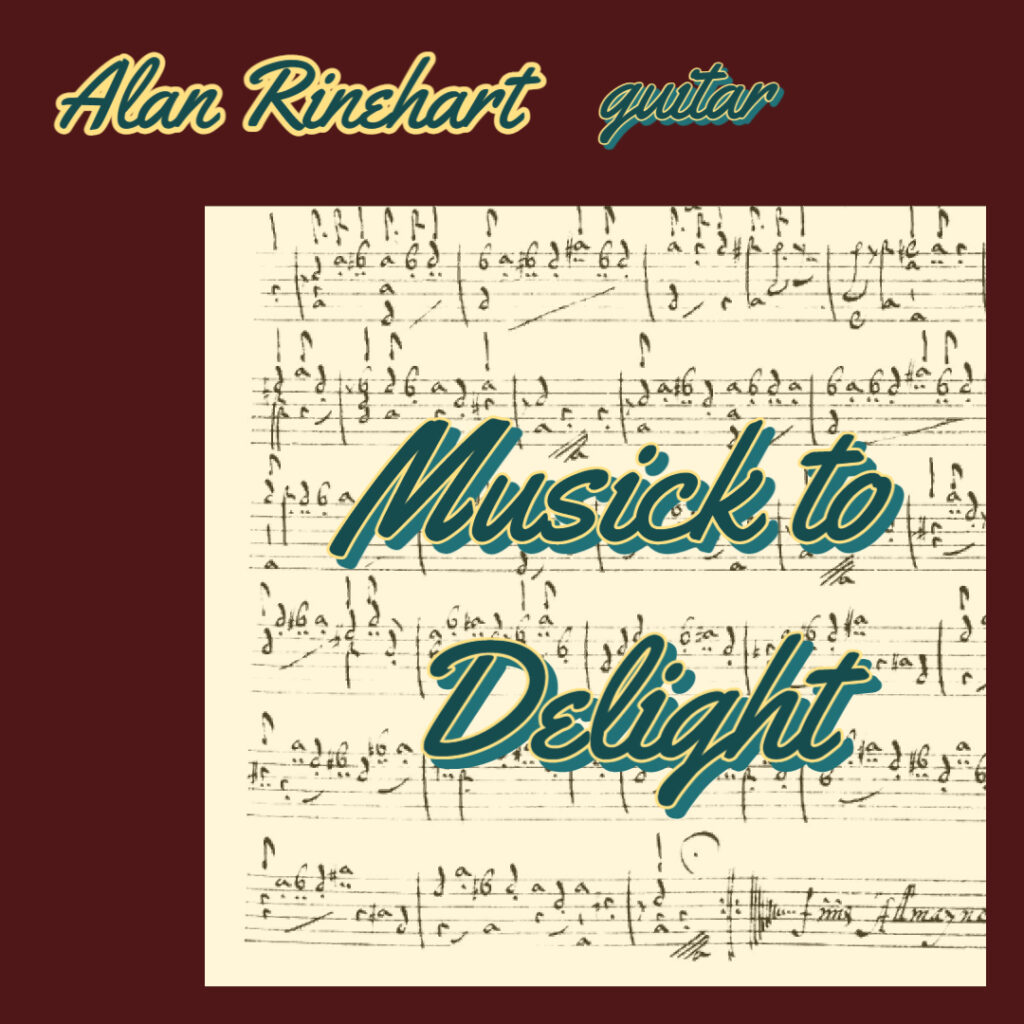Musick to Delight

Classical guitarist Alan Rinehart delights and keeps the mood light with his performance of Queen Elizabeth’s Galliard by John Dowland. This transcription is well suited for the guitar, and contains all of the necessary elements without being overly burdened by embellishments. Alan plays with a sweet and robust tone. He approaches the piece with confidence and a calm demeanor. His sound makes the music catapult out of the guitar. It is a more old-school approach to Dowland that still sounds wonderfully magical.
RADIO AIRPLAY REVIEW
Musick to Delight track list
track title composer source time
1 Preludium* John Dowland (1563-1626) 1 1:05
2 The English Hunt’s Up* John Whitfield (fl.1600) 2 1:10
3 The Gillyflower** anon. 1 1:05
4 Almaine* Francis Cutting (1550-1595/6) 7 1:25
5 Galliard (10)* 5 2:05
6 Greensleeves* 7 1:17
7 Galliard (32)* 10 1:54
8 Sellinger’s Round** anon. 1 :59
9 The Scottish Hunt’s Up* John Whitfield 8 3:10
10 Pavan to Delight** John Johnson (1545-1594) 1 1:58
11 Galliard to Delight** 1 1:35
12 Passemeasures Pavan** 8 4:21
13 Alman ‘The Gathering of Pescods’** 1 :51
14 Go From My Window** anon. 1 1:19
15 A Dream* anon. 1 2:07
16 A Fancy* John Dowland 11 2:47
17 Fortune My Foe** 9 2:02
18 The Most Sacred Queen Elizabeth, Her Galliard** 13 1:16
19 Lachrymae Pavan** 10 4:03
20 The Frog Galliard** 12 1:51
21 Fantasy* 11 3:28
22 The Scolding Woman** anon. 1 :41
23 I Cannot Keep My Wife At Home** anon. 1 :27
24 Galliard ‘My Selfe’* Anthony Holborne (1545-1602) 10 1:44
25 Pavan ‘The Countess of Pembroke’s Funeral’* 10 4:19
26 Pavan ‘The Countess of Pembroke’s Paradise’* 6 2:45
27 Heart’s Ease* 8 1:53
28 The French King’s Masque** anon. 1 1:03
29 The Duke of Milan’s Dump* anon. 8 1:56
30 Fantasia* Robert Johnson (1583-1633) 4 2:46
31 Alman ‘The Prince’s’* 3 1:10
32 Alman* 3 1:16
33 Alman ‘Hit and Take It’* 3 1:44
34 The Carman’s Whistle* 2 and 10 4:11
TOTAL 68:15
guitars: * Fritz Mueller ** Masaru Kohno
Alan would like to thank Jack Narsted for his help in post-production and Greg Koch for mastering the recording.
Sources:
1 Private Library of Robert Spencer Margaret Board lute book
2 British Library Eg.2046 Jane Pickering lute book
3 British Library Add 38539 Sturt lute book
4 Fitzwilliam Museum ms 3-1956 Herbert of Cherbury’s lute book
5 Glasgow University Library ms r.d.43 Euing lute book
6 Lord Forester Library Welde lute book
7 British Library Add. 31392
8 Cambridge University Library D.d 2.11
9 Cambridge University Library D.d 4.22
10 Cambridge University Library D.d 5.78
11 Cambridge University Library D.d 9.33
12 Folger Shakespeare Library ms 1610
13 A Varietie of Lute Lessons (Robert Dowland)
Elizabethan and Jacobean music possesses a freshness and vitality that has inspired music lovers since the 17th century. The repertoire for the solo lute from this period (@1560-1620), whether simple arrangements of popular songs or elaborate and highly contrapuntal fantasies, represents some of the greatest and most skillfully written music for any instrument.
This recording follows the purpose of my 2010 recording, The Golden Century, that is to perform this music on the guitar as an inspiration to other guitarists to explore the vast repertoire of quality music written originally for the lute. With that in mind I wanted to avoid any attempt to imitate the lute by playing at ‘lute pitch’ (a tone or tone and a half higher) or relying on more modern guitar techniques (re-fingering to make use of tone colour changes and different areas of the fingerboard). This music is performed with Renaissance lute tuning, (the third string tuned down to F#) and played directly from the original manuscript sources, or from a modern tablature edition,with very few changes.
My hope is to open another small door into this wonderful musical world.
A curiosity of the surviving lute repertoire of the Elizabethan and Jacobean period (roughly 1575-1625) is that, unlike the surviving lute repertoire of Europe which is largely in printed books, it is mostly in manuscript form. One of the beauties of manuscripts is the direct connection between the writer and the performer. Compared to the printing process of the day, much more information can be conveyed in a manuscript, especially ornamentation suggestions. The principle drawback to manuscripts is that of readability dependent on the scribe’s penmanship and whether a page is marred by ink bleed-through from other pages. With the exception of one piece from a printed book (The Most Sacred Queen Elizabeth, Her Galliard from ‘A Varietie of Lute Lessons’) all of the music on this recording comes from manuscript sources.
The format that I have chosen to organize the various tracks follows a pattern. Starting with the wonderful Preludium by Dowland, groups of works by principle composers are each separated by two examples of lighter, more popular and, apart from the Hunt’s Up works by John Whitfield, anonymous pieces which were often used as page fillers in manuscript books where a bit of blank space is available after a more substantial works is copied.
Cutting, Holborne, Dowland and John Johnson and his son Robert were all highly regarded professional lutenists and composers with postings in various noble houses in England and mainland Europe. John Johnson was lutenist to the Elizabeth I and Robert was active in Shakespeare’s theatrical productions. John Dowland’s music has inspired modern composers (Benjamin Britten in particular) and songwriters (Sting’s 2006 recording ‘Songs from the Labyrinth’ being totally devoted to Dowland’s music).




